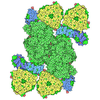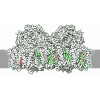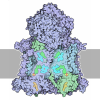+ Open data
Open data
- Basic information
Basic information
| Entry | Database: PDB / ID: 9kqb | ||||||
|---|---|---|---|---|---|---|---|
| Title | PSII-FCPII supercomplex from haptophyte Chrysotila roscoffensis | ||||||
 Components Components |
| ||||||
 Keywords Keywords | PHOTOSYNTHESIS / photosystem II / chlorophyll / light-harvesting complex / energy transfer / LHCII / FCPII / coccolithophore / haptophyte | ||||||
| Function / homology |  Function and homology information Function and homology informationthylakoid membrane / photosynthesis, light harvesting / photosystem II reaction center / photosystem II / photosynthetic electron transport chain / photosystem II / response to herbicide / chlorophyll binding / photosynthetic electron transport in photosystem II / : ...thylakoid membrane / photosynthesis, light harvesting / photosystem II reaction center / photosystem II / photosynthetic electron transport chain / photosystem II / response to herbicide / chlorophyll binding / photosynthetic electron transport in photosystem II / : / chloroplast thylakoid membrane / photosynthesis / chloroplast / electron transfer activity / oxidoreductase activity / iron ion binding / heme binding / metal ion binding / membrane Similarity search - Function | ||||||
| Biological species |  Chrysotila roscoffensis (eukaryote) Chrysotila roscoffensis (eukaryote) | ||||||
| Method | ELECTRON MICROSCOPY / single particle reconstruction / cryo EM / Resolution: 2.22 Å | ||||||
 Authors Authors | La Rocca, R. / Kato, K. / Tsai, P.-C. / Nakajima, Y. / Akita, F. / Shen, J.-R. | ||||||
| Funding support | 1items
| ||||||
 Citation Citation |  Journal: Nat Commun / Year: 2025 Journal: Nat Commun / Year: 2025Title: Structure of a photosystem II-FCPII supercomplex from a haptophyte reveals a distinct antenna organization. Authors: Romain La Rocca / Koji Kato / Pi-Cheng Tsai / Yoshiki Nakajima / Fusamichi Akita / Jian-Ren Shen /  Abstract: Haptophytes are unicellular algae that produce 30 to 50% of biomass in oceans. Among haptophytes, a subset named coccolithophores is characterized by calcified scales. Despite the importance of ...Haptophytes are unicellular algae that produce 30 to 50% of biomass in oceans. Among haptophytes, a subset named coccolithophores is characterized by calcified scales. Despite the importance of coccolithophores in global carbon fixation and CaCO production, their energy conversion system is still poorly known. Here we report a cryo-electron microscopic structure of photosystem II (PSII)-fucoxanthin chlorophyll c-binding protein (FCPII) supercomplex from Chyrostila roscoffensis, a representative of coccolithophores. This complex has two sets of six dimeric and monomeric FCPIIs, with distinct orientations. Interfaces of both FCPII/FCPII and FCPII/core differ from previously reported. We also determine the sequence of Psb36, a subunit previously found in diatoms and red algae. The principal excitation energy transfer (EET) pathways involve mainly 5 FCPIIs, where one FCPII monomer mediates EET to CP47. Our findings provide a solid structural basis for EET and energy dissipation pathways occurring in coccolithophores. | ||||||
| History |
|
- Structure visualization
Structure visualization
| Structure viewer | Molecule:  Molmil Molmil Jmol/JSmol Jmol/JSmol |
|---|
- Downloads & links
Downloads & links
- Download
Download
| PDBx/mmCIF format |  9kqb.cif.gz 9kqb.cif.gz | 1.3 MB | Display |  PDBx/mmCIF format PDBx/mmCIF format |
|---|---|---|---|---|
| PDB format |  pdb9kqb.ent.gz pdb9kqb.ent.gz | 1.2 MB | Display |  PDB format PDB format |
| PDBx/mmJSON format |  9kqb.json.gz 9kqb.json.gz | Tree view |  PDBx/mmJSON format PDBx/mmJSON format | |
| Others |  Other downloads Other downloads |
-Validation report
| Summary document |  9kqb_validation.pdf.gz 9kqb_validation.pdf.gz | 15.8 MB | Display |  wwPDB validaton report wwPDB validaton report |
|---|---|---|---|---|
| Full document |  9kqb_full_validation.pdf.gz 9kqb_full_validation.pdf.gz | 17.2 MB | Display | |
| Data in XML |  9kqb_validation.xml.gz 9kqb_validation.xml.gz | 370.3 KB | Display | |
| Data in CIF |  9kqb_validation.cif.gz 9kqb_validation.cif.gz | 450.2 KB | Display | |
| Arichive directory |  https://data.pdbj.org/pub/pdb/validation_reports/kq/9kqb https://data.pdbj.org/pub/pdb/validation_reports/kq/9kqb ftp://data.pdbj.org/pub/pdb/validation_reports/kq/9kqb ftp://data.pdbj.org/pub/pdb/validation_reports/kq/9kqb | HTTPS FTP |
-Related structure data
| Related structure data |  62499MC M: map data used to model this data C: citing same article ( |
|---|---|
| Similar structure data | Similarity search - Function & homology  F&H Search F&H Search |
- Links
Links
- Assembly
Assembly
| Deposited unit | 
|
|---|---|
| 1 |
|
- Components
Components
-Fucoxanthin chlorophyll a/c binding protein II (FCPII- ... , 4 types, 10 molecules 175g6J284G
| #1: Protein | Mass: 18307.840 Da / Num. of mol.: 4 / Source method: isolated from a natural source / Source: (natural)  Chrysotila roscoffensis (eukaryote) Chrysotila roscoffensis (eukaryote)#2: Protein | Mass: 18451.154 Da / Num. of mol.: 2 / Source method: isolated from a natural source / Source: (natural)  Chrysotila roscoffensis (eukaryote) Chrysotila roscoffensis (eukaryote)#16: Protein | Mass: 24920.742 Da / Num. of mol.: 2 / Source method: isolated from a natural source / Source: (natural)  Chrysotila roscoffensis (eukaryote) Chrysotila roscoffensis (eukaryote)#20: Protein | Mass: 18438.115 Da / Num. of mol.: 2 / Source method: isolated from a natural source / Source: (natural)  Chrysotila roscoffensis (eukaryote) Chrysotila roscoffensis (eukaryote) |
|---|
-Photosystem II ... , 13 types, 26 molecules AaBbHhIiKkLlMmNnTtWwXxDdCc
| #3: Protein | Mass: 39588.004 Da / Num. of mol.: 2 / Source method: isolated from a natural source / Source: (natural)  Chrysotila roscoffensis (eukaryote) / References: UniProt: A0A7S4BZA9 Chrysotila roscoffensis (eukaryote) / References: UniProt: A0A7S4BZA9#4: Protein | Mass: 56324.250 Da / Num. of mol.: 2 / Source method: isolated from a natural source / Source: (natural)  Chrysotila roscoffensis (eukaryote) / References: UniProt: Q4G3C5 Chrysotila roscoffensis (eukaryote) / References: UniProt: Q4G3C5#7: Protein | Mass: 7259.597 Da / Num. of mol.: 2 / Source method: isolated from a natural source / Source: (natural)  Chrysotila roscoffensis (eukaryote) Chrysotila roscoffensis (eukaryote)#8: Protein/peptide | Mass: 4461.228 Da / Num. of mol.: 2 / Source method: isolated from a natural source / Source: (natural)  Chrysotila roscoffensis (eukaryote) Chrysotila roscoffensis (eukaryote)#9: Protein/peptide | Mass: 4461.356 Da / Num. of mol.: 2 / Source method: isolated from a natural source / Source: (natural)  Chrysotila roscoffensis (eukaryote) Chrysotila roscoffensis (eukaryote)#10: Protein/peptide | Mass: 4393.113 Da / Num. of mol.: 2 / Source method: isolated from a natural source / Source: (natural)  Chrysotila roscoffensis (eukaryote) / References: UniProt: D9MYJ9 Chrysotila roscoffensis (eukaryote) / References: UniProt: D9MYJ9#11: Protein | Mass: 13414.595 Da / Num. of mol.: 2 / Source method: isolated from a natural source / Source: (natural)  Chrysotila roscoffensis (eukaryote) Chrysotila roscoffensis (eukaryote)#12: Protein/peptide | Mass: 3458.977 Da / Num. of mol.: 2 / Source method: isolated from a natural source / Source: (natural)  Chrysotila roscoffensis (eukaryote) / References: UniProt: A0A7S4C3N2 Chrysotila roscoffensis (eukaryote) / References: UniProt: A0A7S4C3N2#13: Protein/peptide | Mass: 3776.660 Da / Num. of mol.: 2 / Source method: isolated from a natural source / Source: (natural)  Chrysotila roscoffensis (eukaryote) / References: UniProt: A0A3S6R2W1 Chrysotila roscoffensis (eukaryote) / References: UniProt: A0A3S6R2W1#14: Protein | Mass: 5643.089 Da / Num. of mol.: 2 / Source method: isolated from a natural source / Source: (natural)  Chrysotila roscoffensis (eukaryote) Chrysotila roscoffensis (eukaryote)#15: Protein/peptide | Mass: 3674.456 Da / Num. of mol.: 2 / Source method: isolated from a natural source / Source: (natural)  Chrysotila roscoffensis (eukaryote) Chrysotila roscoffensis (eukaryote)#17: Protein | Mass: 39143.762 Da / Num. of mol.: 2 / Source method: isolated from a natural source / Source: (natural)  Chrysotila roscoffensis (eukaryote) / References: UniProt: Q4G395, photosystem II Chrysotila roscoffensis (eukaryote) / References: UniProt: Q4G395, photosystem II#18: Protein | Mass: 48733.730 Da / Num. of mol.: 2 / Source method: isolated from a natural source / Source: (natural)  Chrysotila roscoffensis (eukaryote) / References: UniProt: A0A075DWU3 Chrysotila roscoffensis (eukaryote) / References: UniProt: A0A075DWU3 |
|---|
-Cytochrome b559 subunit ... , 2 types, 4 molecules EeFf
| #5: Protein | Mass: 9220.330 Da / Num. of mol.: 2 / Source method: isolated from a natural source / Source: (natural)  Chrysotila roscoffensis (eukaryote) / References: UniProt: Q4G380 Chrysotila roscoffensis (eukaryote) / References: UniProt: Q4G380#6: Protein/peptide | Mass: 4858.744 Da / Num. of mol.: 2 / Source method: isolated from a natural source / Source: (natural)  Chrysotila roscoffensis (eukaryote) / References: UniProt: Q4G381 Chrysotila roscoffensis (eukaryote) / References: UniProt: Q4G381 |
|---|
-Protein , 1 types, 2 molecules 93
| #19: Protein | Mass: 23662.523 Da / Num. of mol.: 2 / Source method: isolated from a natural source / Source: (natural)  Chrysotila roscoffensis (eukaryote) / References: UniProt: A0A7S4BJL5 Chrysotila roscoffensis (eukaryote) / References: UniProt: A0A7S4BJL5 |
|---|
-Sugars , 2 types, 17 molecules 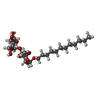
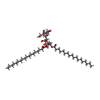

| #29: Sugar | ChemComp-LMU / #30: Sugar | ChemComp-DGD / |
|---|
-Non-polymers , 14 types, 469 molecules 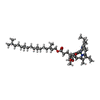

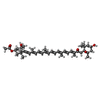
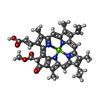
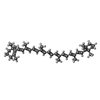

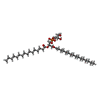
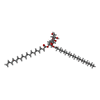
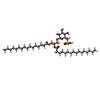
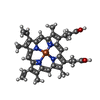
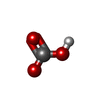
















| #21: Chemical | ChemComp-CLA / #22: Chemical | ChemComp-DD6 / ( #23: Chemical | ChemComp-A86 / ( #24: Chemical | ChemComp-KC1 / #25: Chemical | ChemComp-BCR / #26: Chemical | ChemComp-PHO / #27: Chemical | ChemComp-LHG / #28: Chemical | ChemComp-LMG / #31: Chemical | ChemComp-SQD / #32: Chemical | #33: Chemical | #34: Chemical | #35: Chemical | #36: Water | ChemComp-HOH / | |
|---|
-Details
| Has ligand of interest | Y |
|---|---|
| Has protein modification | N |
-Experimental details
-Experiment
| Experiment | Method: ELECTRON MICROSCOPY |
|---|---|
| EM experiment | Aggregation state: PARTICLE / 3D reconstruction method: single particle reconstruction |
- Sample preparation
Sample preparation
| Component | Name: Photosystem II (PSII)-fucoxanthin chlorophyll a/c binding protein II (FCPII) supercomplex from haptophyte Chrysotila roscoffensis Type: COMPLEX Details: PSII-FCPII supercomplex containing two sets of 6 symmetrical FCPII. Entity ID: #5-#11, #13-#15 / Source: NATURAL | ||||||||||||||||||||
|---|---|---|---|---|---|---|---|---|---|---|---|---|---|---|---|---|---|---|---|---|---|
| Molecular weight | Experimental value: NO | ||||||||||||||||||||
| Source (natural) | Organism:  Chrysotila roscoffensis (eukaryote) Chrysotila roscoffensis (eukaryote) | ||||||||||||||||||||
| Buffer solution | pH: 7.5 | ||||||||||||||||||||
| Buffer component |
| ||||||||||||||||||||
| Specimen | Conc.: 1.53 mg/ml / Embedding applied: NO / Shadowing applied: NO / Staining applied: NO / Vitrification applied: YES | ||||||||||||||||||||
| Specimen support | Grid material: COPPER / Grid mesh size: 300 divisions/in. / Grid type: Quantifoil R1.2/1.3 | ||||||||||||||||||||
| Vitrification | Instrument: FEI VITROBOT MARK IV / Cryogen name: ETHANE / Humidity: 100 % / Chamber temperature: 281 K / Details: Light was turned off during the blot. |
- Electron microscopy imaging
Electron microscopy imaging
| Experimental equipment |  Model: Titan Krios / Image courtesy: FEI Company |
|---|---|
| Microscopy | Model: TFS KRIOS |
| Electron gun | Electron source:  FIELD EMISSION GUN / Accelerating voltage: 300 kV / Illumination mode: FLOOD BEAM FIELD EMISSION GUN / Accelerating voltage: 300 kV / Illumination mode: FLOOD BEAM |
| Electron lens | Mode: BRIGHT FIELD / Nominal magnification: 165000 X / Nominal defocus max: 1800 nm / Nominal defocus min: 800 nm |
| Image recording | Electron dose: 50 e/Å2 / Film or detector model: FEI FALCON IV (4k x 4k) |
- Processing
Processing
| EM software |
| ||||||||
|---|---|---|---|---|---|---|---|---|---|
| CTF correction | Type: PHASE FLIPPING AND AMPLITUDE CORRECTION | ||||||||
| Symmetry | Point symmetry: C2 (2 fold cyclic) | ||||||||
| 3D reconstruction | Resolution: 2.22 Å / Resolution method: FSC 0.143 CUT-OFF / Num. of particles: 38582 / Algorithm: FOURIER SPACE / Num. of class averages: 12 / Symmetry type: POINT |
 Movie
Movie Controller
Controller




 PDBj
PDBj